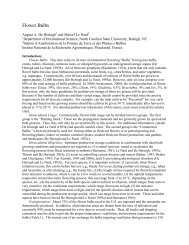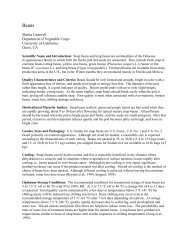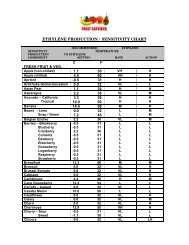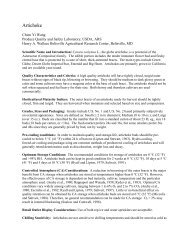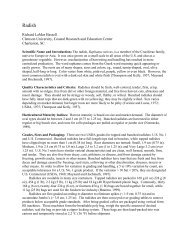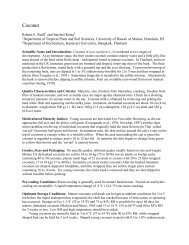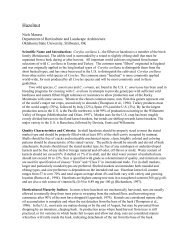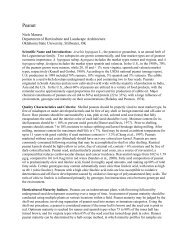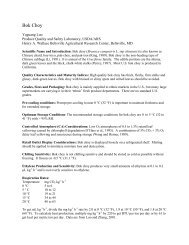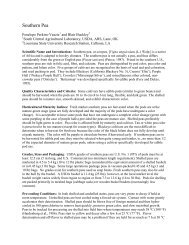Watermelon
Watermelon
Watermelon
Create successful ePaper yourself
Turn your PDF publications into a flip-book with our unique Google optimized e-Paper software.
<strong>Watermelon</strong><br />
James W. Rushing<br />
Clemson University, Coastal Research and Education Center<br />
Charleston, SC<br />
Scientific Name and Introduction: <strong>Watermelon</strong>, Citrullus lanatus (Thunb.) Matsum. and Nakai, is an<br />
annual plant of the Cucurbitaceae family. The edible fruit is produced on trailing vines that may reach 15<br />
ft. (4.6 m) or more in length. Fruit vary in shape from globular to oblong. The color of the hairless skin<br />
varies in shades of green from pale yellowish to almost black and may be solid, striped, or marbled. Fruit<br />
have a thin, firm outer rind, a layer of white-fleshed inner rind that may be up to about one inch thick, and<br />
an interior edible pulp containing seeds unless the variety is triploid. Pulp color of most commercial<br />
varieties is some shade of yellow or red (Sackett, 1974).<br />
Quality Characteristics and Criteria: High quality watermelons should be well formed, symmetrical<br />
and uniform in shape with a waxy, bright appearance. The rind should be free of scars, sunburn, and<br />
abrasions with no bruising or other physical injury, free from anthracnose or other decay, and not overripe<br />
(Suslow, 1999; USDA, 1978).<br />
Horticultural Maturity Indices: As watermelons reach horticultural maturity, the ground spot changes<br />
from white to pale yellow, tendrils nearest the fruit may turn brown and dry, and the fruit surface may<br />
become irregular and dull rather than bright or glossy. Experienced harvest managers may note that when<br />
the fruit is thumped or rapped with the knuckles, immature fruit give off a metallic ringing sound while<br />
mature fruit will sound dull or hollow. The most reliable method of determining maturity within a given<br />
field is to visually examine the fruit for the changes described above, then cut some fruit in random<br />
sectors of the field to check flavor and internal color development. Some buyers require that fruit have<br />
some minimum SSC which is easily measured with a refractometer (Sackett, 1974; Rushing et al., 2000).<br />
Grades, Sizes and Packaging: <strong>Watermelon</strong> grades are U.S. Fancy, U.S. No. 1., and U.S. No. 2.<br />
Determination of grade is subjectively based on the quality characteristics and criteria described above.<br />
Size may be specified in terms of average weight, minimum weight, or minimum and maximum weight<br />
(USDA, 1978). <strong>Watermelon</strong>s may be shipped in bulk, placed on corrugated bins with a capacity of<br />
approximately 1,000 lb (454 kg), or packed into cartons containing from 3 to 6 watermelons depending<br />
on fruit size. Cartons should have specially designed inserts to help support the weight of the fruit (Close<br />
et al., 1971).<br />
Pre-Cooling Conditions: <strong>Watermelon</strong>s generally are not pre-cooled and some are shipped in<br />
unrefrigerated trucks (Suslow, 1999). If pre-cooling is implemented, forced-air cooling would be the<br />
method of choice. In common room-cooling, good air circulation between palletized boxes is essential.<br />
Fruit that are placed in bulk fiberboard bins will cool slowly because of poor air circulation within the<br />
bin.<br />
Optimum Storage Conditions: Some variability is noted in watermelon varieties and types, ie., seeded<br />
vs. seedless, but in general none are suited to very long term storage. The ideal storage temperature is in<br />
the range of 10 to 15 °C (50 to 59 °F) with approximately 90% RH. Fruit should be consumed within 2 to<br />
3 weeks following harvest (Hardenburg et al., 1986).<br />
Controlled Atmosphere (CA) Conditions: <strong>Watermelon</strong>s generally do not respond well to CA or to<br />
MAP. Studies with shrink-wrap packaging of individual fruits, a form of MAP, was not beneficial and in
some cases decay in MAP was higher (Biglete, 1992).<br />
Retail Outlet Display Considerations: <strong>Watermelon</strong>s are usually sold from unrefrigerated displays.<br />
Bulk fiberboard bins with colorful graphics have been a popular method of displaying watermelons for<br />
retail sale.<br />
Chilling Sensitivity: <strong>Watermelon</strong>s develop chilling injury when stored below about 10 °C for more than<br />
a few days. Lower temperatures will hasten the onset of injury. Symptoms appear as brown-staining of<br />
the rind, surface pitting, deterioration of flavor, fading of flesh color, and increased incidence of decay<br />
when returned to room temperatures (Hardenburg et al., 1986; Rushing et al., 2000; Suslow, 1999).<br />
Conditioning fruit at 30 °C for about 4 days prior to cooling has been shown to induce some tolerance to<br />
chilling temperatures, but it does not completely alleviate the problem (Picha, 1986).<br />
Ethylene Production and Sensitivity: <strong>Watermelon</strong>s are classified as low ethylene producers, with<br />
production rates in the range of 0.1 to 1.0 µL kg -1 h -1 at 20 °C. Although production rates are low, fruit<br />
are extremely sensitive to ethylene. Exposure to as little as 5 ppm ethylene causes softening, rind<br />
thinning, flesh color fading, and over-ripeness (Elkashif et al. 1989; Suslow, 1999). Interactions between<br />
ethylene concentration, temperature, and duration of exposure are not well defined. The recommended<br />
management protocol is to avoid any exposure to ethylene in the storage environment.<br />
Respiration Rates:<br />
Temperature mg CO 2 kg -1 h -1<br />
4 to 5 ºC 3 to 4<br />
10 ºC 6 to 9<br />
20 to 21 ºC 17 to 25<br />
To get mL kg -1 h -1 , divide the mg kg -1 h -1 rate by 2.0 at 0 °C (32 °F), 1.9 at 10 °C (50 °F), and 1.8 at 20 °C<br />
(68 °F). To calculate heat production, multiply mg kg -1 h -1 by 220 to get BTU per ton per day or by 61 to<br />
get kcal per metric ton per day. Data are from Hardenburg et al. (1986).<br />
Physiological Disorders: Refer to sections on “Chilling Injury” and “Ethylene Sensitivity.” A disorder<br />
of pre-harvest origin that can have serious postharvest consequences for marketing is hollowheart. The<br />
most effective way of eliminating hollowheart from the marketing chain is to utilize production practices<br />
that prevent its occurrence.<br />
Postharvest Pathology: A variety of pathogens may cause postharvest decay of watermelon, but in the<br />
absence of any approved chemical control measures, the primary defense against the occurrence of decay<br />
is the exclusion of diseased fruit from the marketing chain through careful selection at harvest and<br />
appropriate grading before shipment. Postharvest rots caused by Fusarium spp. and Phytophthora capsici<br />
are of concern because control measures for these fungi in the field often are inadequate. With good<br />
disease control in the field, anthracnose (Colletotrichum orbiculare) and black rot (Didymella bryoniae)<br />
rarely develop on watermelon (Rushing et al., 2000; Snowdon, 1992). In production areas with high RH<br />
and temperature, an extensive list of rind lesions, stem-end or blossom-end rots, and surface lesions may<br />
be caused by Erwinia or an assortment of fungi (Snowdon, 1992; Suslow, 1999). <strong>Watermelon</strong> fruit<br />
blotch (Acidovorax avenae subsp. citrulli) was a postharvest problem for several years, but research<br />
demonstrated the disease is not easily transmitted from fruit to fruit after harvest. Appropriate grading<br />
and temperature management can virtually eliminate its presence in the marketing chain (Rushing et al.,<br />
1999).<br />
Quarantine Issues: <strong>Watermelon</strong>s destined for export must be free of disease, insects, soil, or vegetative
debris. Phytosanitary requirements in the receiving country should be reviewed prior to shipment.<br />
Suitability as Fresh-cut Product: The fresh-cut market for watermelon cubes and slices has grown<br />
dramatically in recent years, but most processing is done near the point of sale. Some benefits may be<br />
derived by MAP. Fresh-cut watermelon is badly damaged by rough handling stress imposed during<br />
distribution (Sargent, 1998).<br />
Special Considerations: Special care should be given to avoid rough handling injury of watermelon<br />
fruit during harvesting and handling. Fruit that are inadvertently dropped during harvest or handling<br />
should not be shipped. Injury that may not be obvious at the moment it occurs can develop into bruised<br />
areas and damage to the flesh in-transit.<br />
References:<br />
Biglete, N.A. 1992. Packaging and storage of watermelon using different shrink-wrap techniques. M.S.<br />
Thesis, Clemson Univ., Clemson SC.<br />
Close, E.G., J. Varick and L.A. Risse. 1971. Comparative methods of handling watermelons - bulk and<br />
cartons. Florida Dept. Agric. Consumer Serv. Series MA 1-71, 17 pp.<br />
Elkashif, M.E., D.J. Huber and J.K. Brecht. 1989. Respiration and ethylene production in harvested<br />
watermelon fruit: evidence for non-climacteric respiratory behavior. J. Amer. Soc. Hort. Sci. 114:<br />
81-85.<br />
Hardenburg, R.E., A.E. Watada and C.Y. Wang. 1986. The Commercial Storage of Fruits, Vegetables,<br />
and Florist and Nursery Stocks. USDA-ARS Handbook No. 66, pp. 12, 62.<br />
Picha, D.H. 1986. Postharvest fruit conditioning reduces chilling injury in watermelons. HortScience<br />
21:1407-1409.<br />
Rushing, J.W., A.P. Keinath and W.P. Cook. 1999. Postharvest development and transmission of<br />
watermelon fruit blotch. HortTechnology 9: 33-35.<br />
Rushing, J.W., J.M. Fonseca and A.P. Keinath. 2000. Harvesting and Postharvest Handling. In:<br />
<strong>Watermelon</strong>s Handbook. Amer. Soc. Hort. Sci. Press (In Press).<br />
Sackett, C. 1974. <strong>Watermelon</strong>s. Fruit and Vegetable Facts and Pointers. United Fresh Fruit and Vegetable<br />
Assoc. Alexandria, VA.<br />
Sargent, S.A. 1998. Fresh-cut watermelon. Citrus and Veg. Mag. 62: 26-28, 44.<br />
Suslow, T.V. 1999. <strong>Watermelon</strong>, in Fresh Produce Facts. Univ. of Calif. Refer to website<br />
http://postharvest.ucdavis.edu/produce/producefacts/fruit/watermelon.html<br />
Snowdon, A.L. 1992. Color atlas of postharvest diseases and disorders of fruits and vegetables, Vol. 2:<br />
Vegetables. pp. 18, 51.<br />
USDA. 1978. U.S. standards for grades of watermelons. Agricultural Marketing Service. www.usda.gov.



